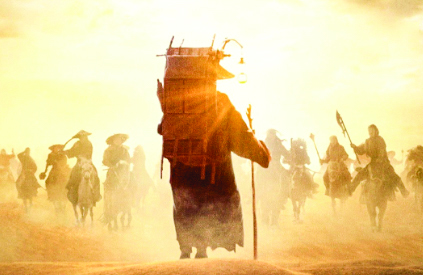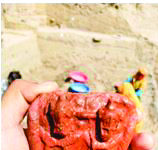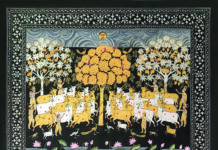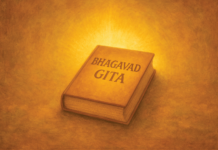Rediscovering sacred wisdom and discernment in modern times
There is a story of a Chinese monk who set out westward in search of sacred scriptures, accompanied by a mischievous monkey, a gluttonous pig, and a loyal river ogre. This fantastical tale of pilgrimage is from the classic novel “Journey to the West: A Spiritual Quest.” Written in the 16th century by Wu Cheng’en, this Chinese folktale is arguably East Asia’s most beloved literary fantasy and one of the four great classical novels of Chinese literature.
‘Journey to the West: A Spiritual Quest’ is a novel about a kind and devout monk, Tripitaka, who is chosen by Buddha to embark on a quest for sacred Buddhist sutras. Divine disciples, each representing different facets of human nature, accompany him for protection. They include Sun Wukong (The Monkey King), Zhu Bajie (Pigsy), Sha Wujing (Sandy), and the Dragon Prince. Together, they encounter 81 trials and grow through them; their outward journeys serve as metaphors for their inner enlightenment. In the end, they discover the sacred sutras in the birthplace of the Buddha, Tenjiku, which will aid them in reviving Buddhism back home.
The novel transcends being merely a story; it serves as a civilisational memory and a bridge between East Asia and India. The destination they set off for was India. They referred to India as Tianzhu in Chinese and Tenjiku in Japanese, which means “the land of heaven.”
Interestingly, this fantastical journey is inspired by a real historical event. In the 7th century, the monk Xuanzang travelled to India, chronicling his pilgrimage in Da Tang Xiyu Ji (Records of the Western Regions). His seminal work provided meticulous details of Indian geography, polity, culture, and scholastic life, forming the basis for Journey to the West. It also became a foundational source for understanding India in the Sinosphere. Over time, the story evolved into the hundred-chapter epic we know as Journey to the West.
Many other books celebrated Tenjiku. The Chronicles of Japan, also known as the Nihon Shoki, compiled in 720 CE, include references to Tenjiku as the origin of Buddhism. When monks from Baekje (Korea) introduced Buddhism to Japan, they brought with them the aura of Tenjiku. As a result, Tenjiku became synonymous with India’s sacred aura, as it was the land that taught dharma and the land that gave birth to the Buddha.
Thus, in Japanese consciousness, Tenjiku came to symbolise a source of ultimate knowledge and virtue. Over time, elements of Sanatana Dharma, including its cosmology, rituals, epics, and spiritual vocabulary, also permeated their cultural and intellectual imagination. When China, Japan, and Korea embraced Buddhism, they inherited much more—karma, dharma, yuga, kalpa, chakra, dhyāna (Zen), and ātm—concepts embedded in the Indic worldview.
Could this shared philosophical soil explain why modern Indians readily embrace practices like Reiki, Pranic Healing, Zen meditation, and even Tai Chi and Qi Gong? They do not feel like foreign imports, but rather like ancient echoes returning home—recognised by an ancestral memory.
The reverence for Tenjiku extended beyond monks. In the 17th century, the Japanese merchant and adventurer Tokubei became so enamoured with India that he adopted the name Tenjiku Tokubei. He undertook a perilous journey to reach the land of the Buddha, and his story later inspired Kabuki and Bunraku theatre in Japan.
The echoes of Tenjiku are not relics; today, Buddhist institutions such as Fo Guang Shan in Taiwan still refer to India as Tenjiku when discussing the life of the Buddha. While some may have viewed India as a destination for plunder, many others were drawn to a greater treasure: its sacred wisdom.
Today, pop culture—through anime, manga, and tactical role-playing games—carries subtle echoes of Tenjiku. “Avatar: The Last Airbender“ and RPGs like “Shin Megami Tensei” or “Final Fantasy Tactics” borrow heavily from Indic and East Asian cosmology, exploring themes such as dharma, struggle, virtue, and war. The horror comedy “Dororon Enma-kun” draws inspiration from Buddhist underworld myths; “Naruto” explores inner power and the burden of protection, while “Dragon Ball” is loosely based on “Journey to the West,” and “Saiyuki” retells it with a darker twist.
A decisive moment in JTTW occurs during the episode of the White Bone Spirit. A cunning demoness is intent on consuming Tripitaka’s flesh to attain immortality. Disguising herself in three successive human forms—a village girl, an old woman, and an old man—she attempts to deceive the group but is recognised by Sun Wukong and subsequently destroyed. However, Tripitaka, unable to perceive the disguise, banishes Wukong. Without him, the group is quickly captured by demons. Tripitaka realises the gravity of his mistake. He has allowed compassion to override discernment—and nearly lost everything. This episode signifies a turning point: Tripitaka learns that non-violence without viveka (wisdom) enables adharma. The story reminds us that Dharma requires clarity and courage, as well as the strength to fight in its defence.
Why does this ancient tale resonate so deeply today? On 22 April, when terrorists brutally murdered innocent tourists in Pahalgam, it was an unmistakable act of adharma—a transgression against righteousness—perpetrated with the backing of a neighbouring nation.
Operation Sindoor, still underway, represents the Dharmic response. It exemplifies a struggle between Dharma and Adharma—between truth and deceit, justice and tyranny. This is not merely a war of weapons; it is also a war of narratives. Adharma frequently masquerades as virtue, sowing doubt through illusion and deception. Illusion breeds confusion. As tensions rise and truths become blurred, we must remain vigilant against the deception that erodes our judgement—lest we forget who stands in our defence and mistakenly turn against our protectors, leaders, and guardians.
Now is the moment for viveka—discernment born of courage. We must clearly see who our Wukong is: who truly guards our frontiers, who enables their strength, and who seeks to undermine them from within. This is a call not only to defend our borders but to protect the sacred spirit of Tenjiku—our ancient, enduring essence.
Aarti Pathak is an author and Consultant with the Centre for Human Sciences at Rishihood University








